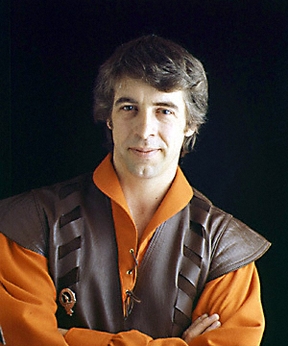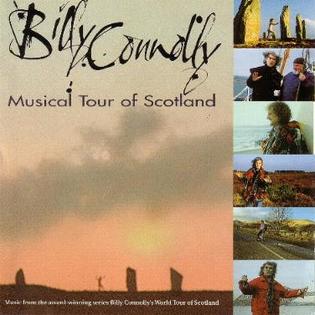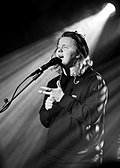
"Flower of Scotland" is a Scottish song, frequently performed on special occasions and at sporting events as the unofficial National anthem of Scotland.

The Incredible String Band were a British psychedelic folk band formed by Clive Palmer, Robin Williamson and Mike Heron in Edinburgh in 1966. The band built a considerable following, especially in the British counterculture, notably with their albums The 5000 Spirits or the Layers of the Onion (1967), The Hangman's Beautiful Daughter (1968), and Wee Tam and the Big Huge (1968). They became pioneers in psychedelic folk and, through integrating a wide variety of traditional music forms and instruments, in the development of world music.

Roy Murdoch Buchanan Williamson was a Scottish songwriter and folk musician, most notably with The Corries. Williamson is best known for writing "Flower of Scotland", which has become the de facto national anthem of Scotland used at international sporting events.

Ronald Grant Browne is a Scottish folk musician and songwriter, who is a founding member of The Corries.

The bandurria is a plucked chordophone from Spain, similar to the mandolin and bandola, primarily used in Spanish folk music, but also found in former Spanish colonies.
Patricia Margaret Bell professionally known as Paddie Bell, was a Scottish folk singer and musician, born in Northern Ireland.

Peat Fire Flame is an album recorded in 1977 by The Corries, a Scottish folk group. The combolin is heard to advantage on "Come By the Hills". Williamson and Ronnie Browne are heard on the vocals. There is multi-tracking to include both men on guitars, Northumbrian pipes, harmonicas, whistles, flutes, concertina, mandolins, boranns, fiddle and combolins. The last four tracks are designed to be heard as one continuous track. Running time: 38 minutes 13 seconds.

Released in 1980, Stovies is the eighteenth album by The Corries. Recorded at one or more live concerts, most of the songs have spoken introductions. As well as two Jacobite folk songs written by the band, the release includes a tribute to Rob Roy.

James Michael Heron is a Scottish singer, songwriter and multi-instrumentalist, best known for his work in the Incredible String Band in the 1960s and 1970s.
The Bluebells of Scotland is the usual modern name for a Scottish folksong. It was written by Dora Jordan, an English actress and writer. First published in 1801.

The Corrie Folk Trio and Paddie Bell is the eponymous 1964 album by The Corrie Folk Trio and Paddie Bell.

The Promise of the Day is a music album by the band The Corrie Folk Trio and Paddie Bell. The album was produced in 1965.

Malinky is a Scottish folk band specialising in Scots song, formed in autumn 1998.

Musical Tour of Scotland is a collection of traditional and original songs and tunes which accompanied Billy Connolly's 1994 television series World Tour of Scotland. It was released in 1995.
The Combolin was invented by Roy Williamson of The Corries in the summer of 1969. The combolin combined several instruments into a single instrument. One combined a mandolin and a guitar, the other combined guitar and the Spanish bandurria, the latter being an instrument Williamson had played since the early days of the Corrie Folk Trio.
"Roses of Prince Charlie" is a modern Scottish folk song composed by Ronnie Browne of The Corries. It was written circa 1973 and first appeared in their album released in 1974, Live From Scotland Volume 1. The title of the song refers to the symbol of Charles Edward Stuart, which was a white rose. The words represent Jacobitism and modern Scottish Nationalism.
Live from Scotland Volume 1 was a 1974 album by The Corries recorded at the Glasgow City Halls.
Live from Scotland Volume 2 was a 1975 album by The Corries recorded at the Glasgow City Halls, Motherwell Town Hall, Dunfermline Carnegie Hall and Edinburgh Usher Hall, in 1974 and 1975.
The "Uist Tramping Song", "Null do dh'Uidhist" (Over to Uist) or "Tiugainn Leam" (Come With Me) is a traditional Scottish folk song, Gaelic lyrics by Archibald MacDonald, music by John R. Bannerman, arranged by Hugh S. Roberton. The song is an invitation to the sights and abundance of Uist, the central group of islands in the Outer Hebrides. The English language version tells of hiking there. Artists who have recorded this song include Kenneth McKellar, Robert Wilson and Robert Rees. Other notable recorded versions, include:
Lock the Door, Lariston is a border ballad by the Scottish poet James Hogg, the "Ettrick Shepherd", first published in 1811. It describes a sixteenth-century armed raid by English border reivers across the Anglo-Scottish border, met and defeated by Scottish borderers led by Jock Elliott of Lariston. Written in a traditional form, it was set to music by the 1850s, and is now a commonly performed Scottish folk song.












